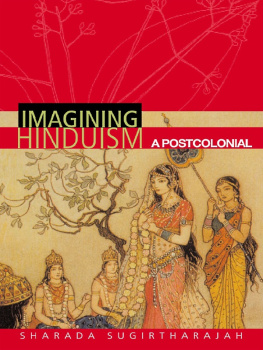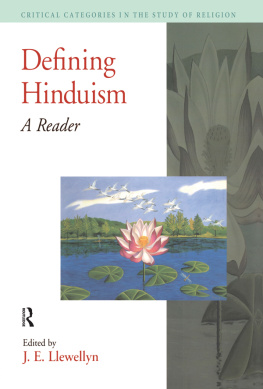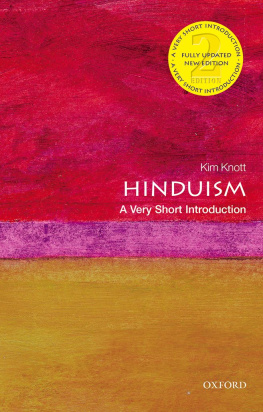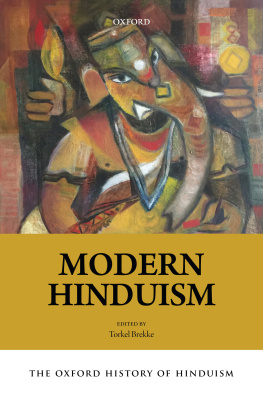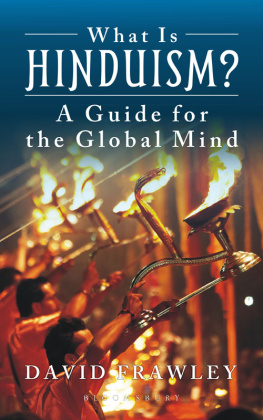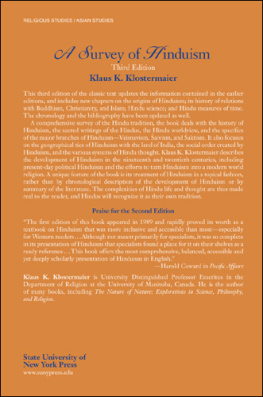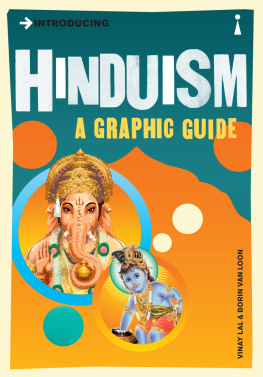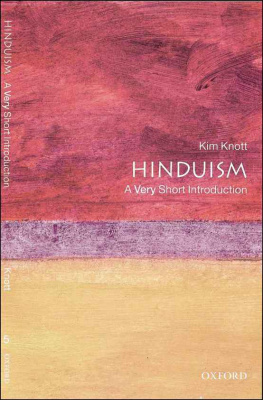Sugirtharajah - Imagining Hinduism
Here you can read online Sugirtharajah - Imagining Hinduism full text of the book (entire story) in english for free. Download pdf and epub, get meaning, cover and reviews about this ebook. year: 2011, publisher: Taylor & Francis (CAM), genre: Religion. Description of the work, (preface) as well as reviews are available. Best literature library LitArk.com created for fans of good reading and offers a wide selection of genres:
Romance novel
Science fiction
Adventure
Detective
Science
History
Home and family
Prose
Art
Politics
Computer
Non-fiction
Religion
Business
Children
Humor
Choose a favorite category and find really read worthwhile books. Enjoy immersion in the world of imagination, feel the emotions of the characters or learn something new for yourself, make an fascinating discovery.
- Book:Imagining Hinduism
- Author:
- Publisher:Taylor & Francis (CAM)
- Genre:
- Year:2011
- Rating:5 / 5
- Favourites:Add to favourites
- Your mark:
- 100
- 1
- 2
- 3
- 4
- 5
Imagining Hinduism: summary, description and annotation
We offer to read an annotation, description, summary or preface (depends on what the author of the book "Imagining Hinduism" wrote himself). If you haven't found the necessary information about the book — write in the comments, we will try to find it.
Imagining Hinduism — read online for free the complete book (whole text) full work
Below is the text of the book, divided by pages. System saving the place of the last page read, allows you to conveniently read the book "Imagining Hinduism" online for free, without having to search again every time where you left off. Put a bookmark, and you can go to the page where you finished reading at any time.
Font size:
Interval:
Bookmark:

First published 2003
by Routledge
11 New Fetter Lane, London EC4P 4EE
Simultaneously published in the USA and Canada
by Routledge
29 West 35th Street, New York, NY 10001
Routledge is an imprint of the Taylor & Francis Group
This edition published in the Taylor & Francis e-Library, 2004.
2003 Sharada Sugirtharajah
All rights reserved. No part of this book may be reprinted or reproduced or utilized in any form or by any electronic, mechanical, or other means, now known or hereafter invented, including photocopying and recording, or in any information storage or retrieval system, without permission in writing from the publishers.
British Library Cataloguing in Publication Data
A catalogue record for this book is available from the British Library
Library of Congress Cataloging in Publication Data
Imagining hinduism
p. cm.
1. HinduismStudy and teaching. 2. Orientalism.
BL1205.I43 2003
294.5'07'22dc21 2003046539
ISBN 0-203-63411-X Master e-book ISBN
ISBN 0-203-63749-6 (Adobe eReader Format)
ISBN 0-415-25743-3 (hbk)
ISBN 0-415-25744-1 (pbk)
Imagining Hinduism introduces a new and significant way of looking at Western constructions of Hinduism. Employing current postcolonial categories, Sharada Sugirtharajah examines how Hinduism has been defined, interpreted and manufactured through Western categorizations, from the foreign interventions of the eighteenth- and nineteenth-century Orientalists and missionaries to the present day. Her contention is that ever since early Orientalists discovered the ancient Sanskrit texts and the Hindu Golden Age, the West has nurtured a complex and ambivalent fascination with Hinduism, responding to it in ways ranging from romantic admiration to ridicule. At the same time, she focuses attention on how Hindu discourse has drawn upon Orientalist representations in order to redefine Hindu identity and construct a monolithic Hinduism, both in the Indian and diasporic contexts.
As the first comprehensive work to bring postcolonial critique to the study of Hinduism, Imagining Hinduism is essential reading for an informed and critical understanding of how both Europeans and Hindus engage with Hinduism.
Sharada Sugirtharajah is Lecturer in Hindu Studies at the University of Birmingham.
To the Mother
I wish to express my sincere thanks to many people who have, directly or indirectly, made possible the writing of this book. First, to Roger Thorp who showed a keen interest in my proposal and commissioned this volume. Although he is no more with Routledge, I owe him a deep sense of gratitude. After Rogers departure, Clare Johnson of Routledge was of immense help and I would like to express my thanks to her. I would also like to thank staff at the Orchard Learning Resource Centre Debbie, Pauline, Jane, Sandy, and particularly Clare and Rachel who made stock-room materials available. My sincere thanks, as well, to Dorothy for procuring the material I most needed. I owe a special debt of gratitude to my long-time friend Lorraine for her meticulous reading of draft chapters and insightful suggestions, and for the many hours of discussion and for her constant support all through the writing of the book. I am immensely grateful to Ralph Broadbent who came to my rescue whenever I ran into computer glitches and needed his help. I also wish to thank various members of my family in India, especially my sister, Savithri, who took such an interest in my research. I would like to express my sincere thanks to my copy editor, Dilys Hartland, for her understanding and patience. My thanks are also due to the Journal of Feminist Studies in Religion and to Studies in World Christianity for permission to republish my papers (with some changes) that have appeared in their journals. Finally, my deepest personal gratitude to my husband, Sugi, whose expertise in postcolonial studies and incisive comments on my work have helped me enormously to focus and tighten my arguments. I am also grateful to him for his unfailing encouragement and his intellectual and emotional support, but more importantly, for believing with me in womens akti.
Introduction Hinduism has long been a central feature in Western consciousness. Ever since the West first came into contact with it, the tradition has been defined and interpreted mainly in Western categories. Western responses to Hinduism have been varied, complex, and ambivalent, ranging from romantic admiration to ridicule. What this volume seeks to do is to investigate some of these representations from a postcolonial perspective. Taking a brief look at the emergence of the concept Hinduism, it examines European orientalist and missionary constructions of Hinduism during the colonial period, and also examines how such representations impacted on Hindus in India and in the diaspora. The volume draws attention to how Hindu movements in the diaspora replicate orientalist articulations of Hinduism. In looking at these constructions of Hinduism, the volume aims to show how Hinduism came to be tailored to fit the varied hermeneutical and ideological positions of both Western and Indian interpreters, all of whom, on their own terms, tried to homogenize a loosely knit tradition and invest it with a tight structure, thereby making it static, fixed, and palatable. Before we proceed further, a brief note about the contentious terms, Hinduism and postcolonialism.
Defining, naming or classifying the Other is not peculiar to any one culture. Rather, it takes place within, as well as with respect to, other cultures. Naming the Other becomes problematic when one party tries to domesticate the Other. The term Hindu, which comes from the Sanskrit word Sindhu (the River Indus), was initially used by Persian-speaking Muslims to refer to those who lived in that geographical area near the River Indus, regardless of the residents particular religious affiliation. In its earlier phase, the term was applied to all non-Muslims, and did not always carry a specific religious significance. It was used in more than one sense by Muslims, sometimes for adherents of a non-Islamic religion, sometimes referring to the local inhabitants, and sometimes used in a geographical sense (Thapar 1993: 79). The use of the term as a religious category became explicit when Muslim conquerors used it to refer to the religious practices of the inhabitants whom they encountered in that geographical region. It became a convenient label to describe and at the same time to differentiate themselves from the local inhabitants. The fact that the term Hindu had a geographic connotation did not imply that the indigenous people had no sense of religious consciousness or identity. On the contrary, the people were from diverse communities which had their own languages, social and religious identities, customs and modes of worship. The point is that the term Hindu did not suggest any of the uniformity that it came to acquire later. The appropriation of the term by Hindus themselves can be traced back to the fifteenth century, in the literature of bhakti sects influenced by Islamic thought. In Kabrs verses one finds a reference to Hindus and Turukas (Muslims), Kabr himself being a product of both Hindu and Islamic cultures (Thapar 1993: 79). Initially perhaps the term was used by Hindus to distinguish themselves from Muslims, but there was no implication of Hinduism as a uniform system of religion in the Enlightenment sense. In other words, religion did not entail an adherence to a set of prescribed beliefs or a uniform creed, a single book or a single authority.
Font size:
Interval:
Bookmark:
Similar books «Imagining Hinduism»
Look at similar books to Imagining Hinduism. We have selected literature similar in name and meaning in the hope of providing readers with more options to find new, interesting, not yet read works.
Discussion, reviews of the book Imagining Hinduism and just readers' own opinions. Leave your comments, write what you think about the work, its meaning or the main characters. Specify what exactly you liked and what you didn't like, and why you think so.

